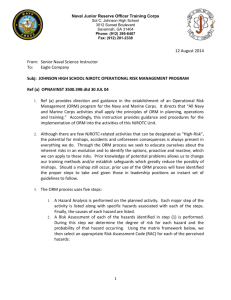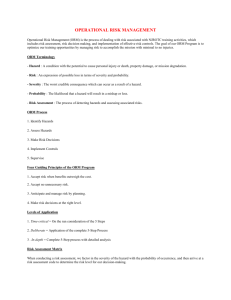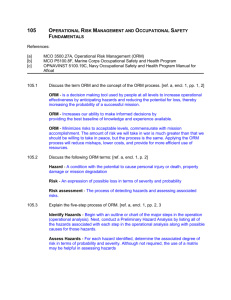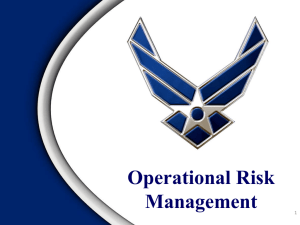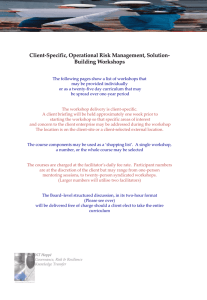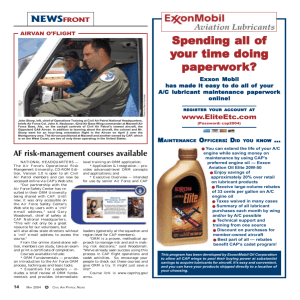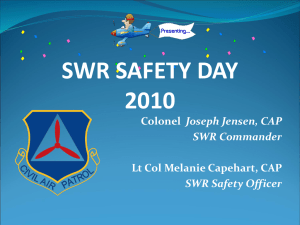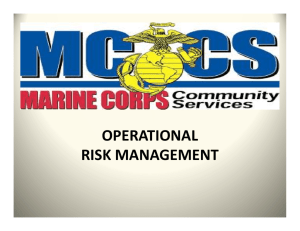version - St Amant NJROTC
advertisement
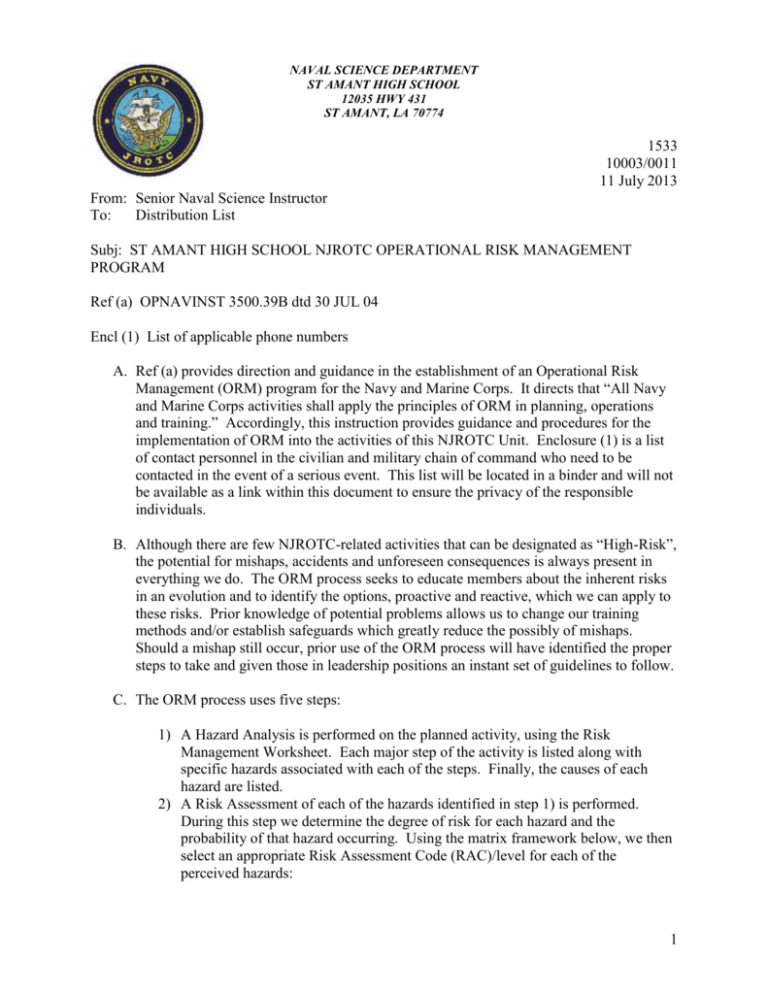
NAVAL SCIENCE DEPARTMENT ST AMANT HIGH SCHOOL 12035 HWY 431 ST AMANT, LA 70774 1533 10003/0011 11 July 2013 From: Senior Naval Science Instructor To: Distribution List Subj: ST AMANT HIGH SCHOOL NJROTC OPERATIONAL RISK MANAGEMENT PROGRAM Ref (a) OPNAVINST 3500.39B dtd 30 JUL 04 Encl (1) List of applicable phone numbers A. Ref (a) provides direction and guidance in the establishment of an Operational Risk Management (ORM) program for the Navy and Marine Corps. It directs that “All Navy and Marine Corps activities shall apply the principles of ORM in planning, operations and training.” Accordingly, this instruction provides guidance and procedures for the implementation of ORM into the activities of this NJROTC Unit. Enclosure (1) is a list of contact personnel in the civilian and military chain of command who need to be contacted in the event of a serious event. This list will be located in a binder and will not be available as a link within this document to ensure the privacy of the responsible individuals. B. Although there are few NJROTC-related activities that can be designated as “High-Risk”, the potential for mishaps, accidents and unforeseen consequences is always present in everything we do. The ORM process seeks to educate members about the inherent risks in an evolution and to identify the options, proactive and reactive, which we can apply to these risks. Prior knowledge of potential problems allows us to change our training methods and/or establish safeguards which greatly reduce the possibly of mishaps. Should a mishap still occur, prior use of the ORM process will have identified the proper steps to take and given those in leadership positions an instant set of guidelines to follow. C. The ORM process uses five steps: 1) A Hazard Analysis is performed on the planned activity, using the Risk Management Worksheet. Each major step of the activity is listed along with specific hazards associated with each of the steps. Finally, the causes of each hazard are listed. 2) A Risk Assessment of each of the hazards identified in step 1) is performed. During this step we determine the degree of risk for each hazard and the probability of that hazard occurring. Using the matrix framework below, we then select an appropriate Risk Assessment Code (RAC)/level for each of the perceived hazards: 1 RAC MATRIX Hazard Critical Severity Serious Moderate Minor Mishap Probability Likely Probably 1 1 2 3 1 2 3 2 3 4 3 4 5 4 5 5 RISK ASSESSMENT CODES (RACs) 1 = Critical 2 = Serious 3 = Moderate May Unlikely 4 = Minor 5 = Negligible HAZARD SEVERITY Critical = May cause death, loss of asset or other grave damage. Serious = May cause severe injury, illness, property damage or damage to interests. Moderate = May cause minor injury, illness, property damage, or damage to interests. Minor = Minimal threat. MISHAP PROBABILITY Likely = Likely to occur immediately or in a short period of time. A mishap is expected to occur several times to an individual item or person, or continuously to a group. Probably = Mishap will occur in time. A mishap is reasonably expected to occur some time to an individual item or person, or continuously to a group. May = May occur in time. A mishap is reasonably expected to occur some time to an individual item or person, or several times to a group. Unlikely = Unlikely to occur. 3) Make of list of the hazards from the most serious to the least serious. Attempt to develop controls for each hazard to eliminate the hazard or to reduce the risk. Decide if the potential benefit from this evolution is worth the remaining amount of risk. 4) Take the controls you identified in step 3) and incorporate them in to all written and verbal instructions issued concerning the event. Make specific mention of who is responsible for what actions and when the action item is to be completed. 5) Supervise and enforce the standards and controls. Check to ensure that the controls have the desired effect. D. To ensure its continued use, the ORM process needs to remain flexible. Often, time does not permit the detailed review and planning required to completely address the 5-step ORM process. Because of this fact we use two levels of ORM, each of which is identical except for the level of detail that goes into the process. The two levels are: 2 1) Time Critical ORM. This is an on-the-run mental or oral review of the situation using the five-step ORM process without recording it on paper. This would be the level normally used in the execution of a drill or training period to overcome hazards that were unexpected during the planning process. 2) Deliberate ORM. This is the use of the full five-step process recorded on paper. It is used in the planning phase to ensure that all-important hazards are identified and controls put in place to minimize the change of a mishap occurring. Through this process a detailed ORM risk management worksheet is produced for each generic type event, i.e., Drill Practice, Physical Fitness, Stadium clean up, Hosted Competition, Air Rifle Training, Parades, Inspection, and Civilian Events, and Football Game parking (MSWord format). E. The SNSI and NSI will work closely with the Cadet Staff, during the course of the year, to ensure that all major Unit evolutions, including but not limited to all high-risk evolutions, incorporate deliberate ORM in the planning process. Time Critical ORM will be practiced during all training evolutions. The safety of our Cadets and our equipment is of primary importance. Likewise, the successful accomplishment of Unit events is also important. While every Unit activity has inherent risks, the dedicated use of ORM principals will ensure that the benefits gained from any training evolution will outweigh the risks associated with it. Training on ORM principals and usage will be given to Naval Science IV Cadets during their senior academic school year and it will be practiced throughout the year by the Cadet Staff as the Unit accomplishes its training. Specific documentation of the accomplishment of ORM will be accomplished through the use of the attached ORM Event Form. This form will be filled out by the Cadet Staff for each major Unit activity and every high-risk training evolution. Once complete, it will be reviewed with the NSI/SNSI and will be briefed to the Cadet leadership that will directly be involved in the evolution. The SNSI will update ORM Worksheet Risk Management Forms in July of even odd years. D. T. Beaver CAPT USNR (Ret.) Distribution List: Area 08 Manager (2 copies) Cadet Staff Officers MSGT Daily Ms Mia Edwards (Principal) Ms Beth Templet (Assistant Principal) Ms Marie Parker (President, NJROTC Booster Club) 3
